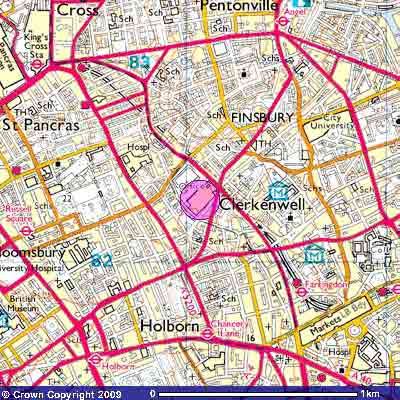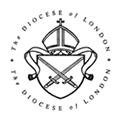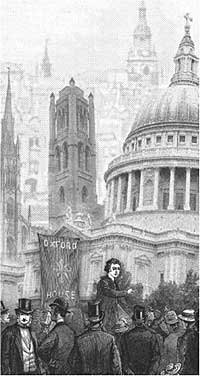Guildhall Library
i. Overview
Guildhall Library was originally founded in 1420 under the terms of Richard Whittington’s will. The modern library was established in 1824 and is a major public reference library specialising in the history of London, especially that of the City. The printed books and visual material will be useful for those researching the history of London and Middlesex parishes. The Manuscript Section is the local archive of the City (the Square Mile) and will be invaluable for conducting research on City parishes. An alphabetical list of city parishes and non-parochial areas can be found on the Guildhall Library website. Further information can also be found in City of London Parish Registers (Guildhall Library, 1999), which can be found in the Manuscript section. The library is also a depository for the Diocese of London and St. Paul’s Cathedral. Before your visit, you might want to take a look at their guides, which can found on their website. At present there is no individual guide for studying parish or diocesan history.
ii. Contact Details
Address
Guildhall Library,
Aldermanbury,
London
EC2P 2EJ
Telephone: (020) 7332 1863
Fax: (020) 7600 3384
Email: manuscripts.guildhall@ms.corpoflondon.gov.uk
See also
Further details on the manuscript section.
Open: Mon-Fri: 9.30-4.45; Sat 9.30-4.45 (no delivery from strong rooms, 12.00-2.00). Closed all bank holidays including Saturday.

Map from www.ordancesurvey.co.uk
iii. Access
Everyone is welcome to consult the Guildhall Library’s collection. You do not have to join. However, it is recommended that you bring some form of identification with you (drivers licence, passport, library or record office card) in case you want to view some of their rare material.
Microfilm and microfiche are on open access to the reader. Hard copy material has to be ordered from the stores. You will need to fill in a Request Slip. Information needed on this slip can be found on their online catalogue, which you can consult at home or in the archive. Once you have filled in the Request Slip, you take it to the Enquiry Desk, where the librarian will place it in a tube-suction system. It should then take 15 minutes to retrieve your order which will be brought to your desk. Please note that some items may need to be ordered in advance.
You are allowed to photocopy material if you have the librarian’s permission. Facilities to print from microfilm and microfiche are also available. Photography (without flash) is allowed as long as it complies with copyright law. Consult the librarian if you are unsure. For all of these you will need to complete an application form which can be obtained from the Enquiry Desk.
Please note that during the refurbishment of Guildhall Library you will only be able to consult their material at London Metropolitan Archives. You will have to order all documents two days in advance, unless already on microfilm. You will be able to consult librarians from Guildhall Library at London Metropolitan Archives.
iv. Catalogue
Much of Guildhall Library’s collections, including manuscripts, can be searched on the City of London libraries catalogue. Instructions on how to use the website can be found on the search page. This is available online.
v. Further Information on Collections
Diocese of London
The Guildhall Library diocesan collections can be divided into four groups:
- Administration
This includes of Bishop Registers, licenses for non-residence and curates, faculty papers, parish terriers, confirmation papers, lists of schoolmaster licenses, parish registers for city churches (see below), precedent books, day books, parliamentary papers, charitable papers [Dr. Richard’s Charity for the Relief of Superannuated and Infirm Clergy and Marriott Bequests], Diocesan Boards and Councils [Clergy Widows Fund] and household papers. - Visitations
This includes Churchwardens’ presentments, completed articles of enquiry for 1905 and 1911, account for procurements, and presentments. - Court Records
This consists of papers relating to the Consistory and Commissary Courts. - Estate Records
This includes papers relating to the Bishop of London’s estates, land tax, and deeds for the City and Westminster.
Diocesan material can also be found in the St. Paul’s Archives reflecting the close relationship the cathedral had with the diocese [more information on the St. Paul’s Archive can be seen below].
More information can be found at www.history.ac.uk/gh/15i.htm. Please be aware that this is not a comprehensive list.
St. Paul’s Cathedral
1. St. Paul’s Archives
The bulk of the St Paul’s Cathedral archives were transferred to Guildhall Library in 1980. This material is primarily concerned with the constitution, administration, services, finances and fabric of the cathedral, together with the Peculiar jurisdiction of the Dean and Chapter and their estates. In the 1960s, the manorial and estate records of the Church Commissioners and probate records were deposited. You will need written permission to consult deeds, leases and estate papers of the Church Commissioners. This can be obtained from
More detailed information can be found on the Guildhall Library website, where a downloadable PDF guide, entitled ‘The St. Paul Archives at Guildhall’, can be found. This leaflet provides the researcher with a history of the cathedral archives and a detailed thematic analysis of what the collection consists of. You are encouraged to contact Manuscript staff at manuscripts.guildhall@ms.corpoflondon.gov.uk if you have a particular enquiry.
2. St Paul's Cathedral Print Collection
This collection includes many of Wren's original drawings for the cathedral. For more details you should contact the Print Room archivist on their email ask.lma@cityoflondon.gov.uk or by telephone 020 7332 3820.
City Parishes
Guildhall Library is also the custodian of the City parishes’ records. These include registers of baptism, marriage and burials, churchwardens’ accounts, vestry minutes, rate assessments, inhabitant lists, and poor law, charity and estate records. You should consult their alphabetical list of city parishes and non-parochial areas if you are unsure if your parish is classified as a ‘City parish’. This can be found on the Guildhall Library website. Further information can also be found in City of London Parish Registers (Guildhall Library, 1999), which can be found in the Manuscript section.
vi. Other Collections of Use
Printed books
Guildhall Library’s printed book section mainly specialises in the City of London (the Square Mile), although it does collect material on the rest of London. You should consult their library catalogue to see if they have any books on your local area. They also have Crockford's Clerical Directory and printed registers of public schools and universities and the London Gazette.
Print Room
The Print Room in Guildhall has an extensive collection of historic maps and pictures of Greater London. Two useful collections are:
1. The Penton Collection
This collection contains 130 pencil drawings of City Churches at the beginning of the twentieth century by the notable marine and landscape artist Howard Penton.
2. Society for Photographing Relics of Old London
The Society for Photographing Relics of Old London was found in 1875 by a group of friends in response to the threatened demolition of the Oxford Arms, a seventeenth-century coaching inn, which was pulled down a few years later. Public enthusiasm led to the extension of this project. The society commissioned Henry Dixon and A. and J. Bool to photograph buildings threatened with demolition. Together Dixon and Bool took 120 photographs for the society. The Guildhall Collection contains….
3. Other sources of interest:
- Prints and drawings of London life and architecture from the 15th century to the present
- Photographs of London streets and buildings from the 1850s to the present
- Panoramas
- London maps from the 16th century to the present (including historic and modern Ordnance Survey large scale plans)
vii. Electronic Collections
COLLAGEWeb address: http://collage.cityoflondon.gov.uk/collage/app
COLLAGE contains some 26,000 prints, maps and drawings from the Library’s collection. It also contains the entire collection of the Guildhall Art Gallery. This includes 6,000 paintings, watercolours, drawings and sculptures. An important part of the collection comprises of work by the Victorian painters Millais, Rossetti and many other notable artists of the period. COLLAGE provides quick and easy access to large areas of Guildhall's visual collections. It invites you to explore the collections using a range of enquiry points. They have also created subtopics which include ‘Abstract Ideas’, ‘Archaeology and Architecture’, ‘History’, ‘Leisure’, Military and War’, ‘Natural World’, ‘Politics’, ‘Religion and Belief’, ‘Society’ and ‘Trade’. You can then view these images on screen and read information about them. They are also available to order either as colour prints or digital files. The collection entitled ‘Religion and Belief’ is particularly important but religious themes also emerge in the other collections. They have also created a grouping ‘Buildings, Religious’ together under the group ‘Places’. This is an alphabetical list of City Churches. This can include pencil drawings, paintings and photographs of the interior and exterior.
See their downloadable PDF leaflet entitled ‘Alphabetical List of City Parishes and Non-Parochial Areas’ available from ‘Guildhall Library Guides’ and under ‘Biographical and Genealogical Sources’. http://www.cityoflondon.gov.uk/Corporation/LGNL_Services/Leisure_and_culture/Libraries/City_of_London_libraries/guildhall+library+guides.htm
See their downloadable PDF leaflet entitled ‘Alphabetical List of City Parishes and Non-Parochial Areas’ available from ‘Guildhall Library Guides’ and under ‘Biographical and Genealogical Sources’.






